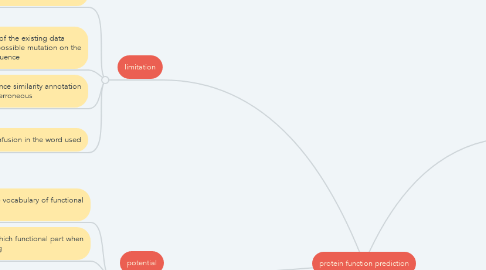
1. limitation
1.1. homology-based annotation
1.1.1. enzyme function not necessarily conserved, so previous data can be unreliable
1.1.2. not sensitive enough
1.2. inaccuracies of the existing data because of possible mutation on the previous sequence
1.3. even high sequence similarity annotation transfer may be erroneous
1.4. confusion in the word used
1.4.1. `function' term depends on various aspect of biological function
1.4.2. vocabulary invented and change daily
2. potential
2.1. standardizing the vocabulary of functional annotation
2.2. specify which functional part when predicting
2.3. protein encoding strategy with an extensive learning algorithm
2.3.1. to control false discovery rate in protein function annotation
2.3.2. result will be systematically compared with the old-fashion similarity-based and de novo approaches
3. new finding
3.1. Structure-Based Protein Function Prediction using Graph Convolutional Networks
3.2. Protein function prediction as a graph-transduction game
3.3. Network propagation for protein function prediction
3.4. A Heterogeneous Information Network Model for Long Non-Coding RNA Function Prediction
4. history
4.1. Arguably Pfam is the database of choice to predict protein function
4.2. founded in 1995 by Erik Sonhammer, Sean Eddy & Richard Durbin
5. future trend
5.1. using graph
5.1.1. automatically identify structure regions at the residue-level that lead to function prediction using class activation mapping (Gligorijevic et.al, 2020)
5.1.2. protein function is modeled as a graph-transduction game (Vascon et.al, 2020)
5.2. using protein architecture
5.2.1. using phylogenetic, domain architecture & gene neighborhood to explore protein function in prokaryotes (Gumerov & Zhulin, 2020)
5.2.2. integrating knowledge of the protein interaction network architecture, protein-domain associations and protein-complex associations (Zhao et.al, 2020)
